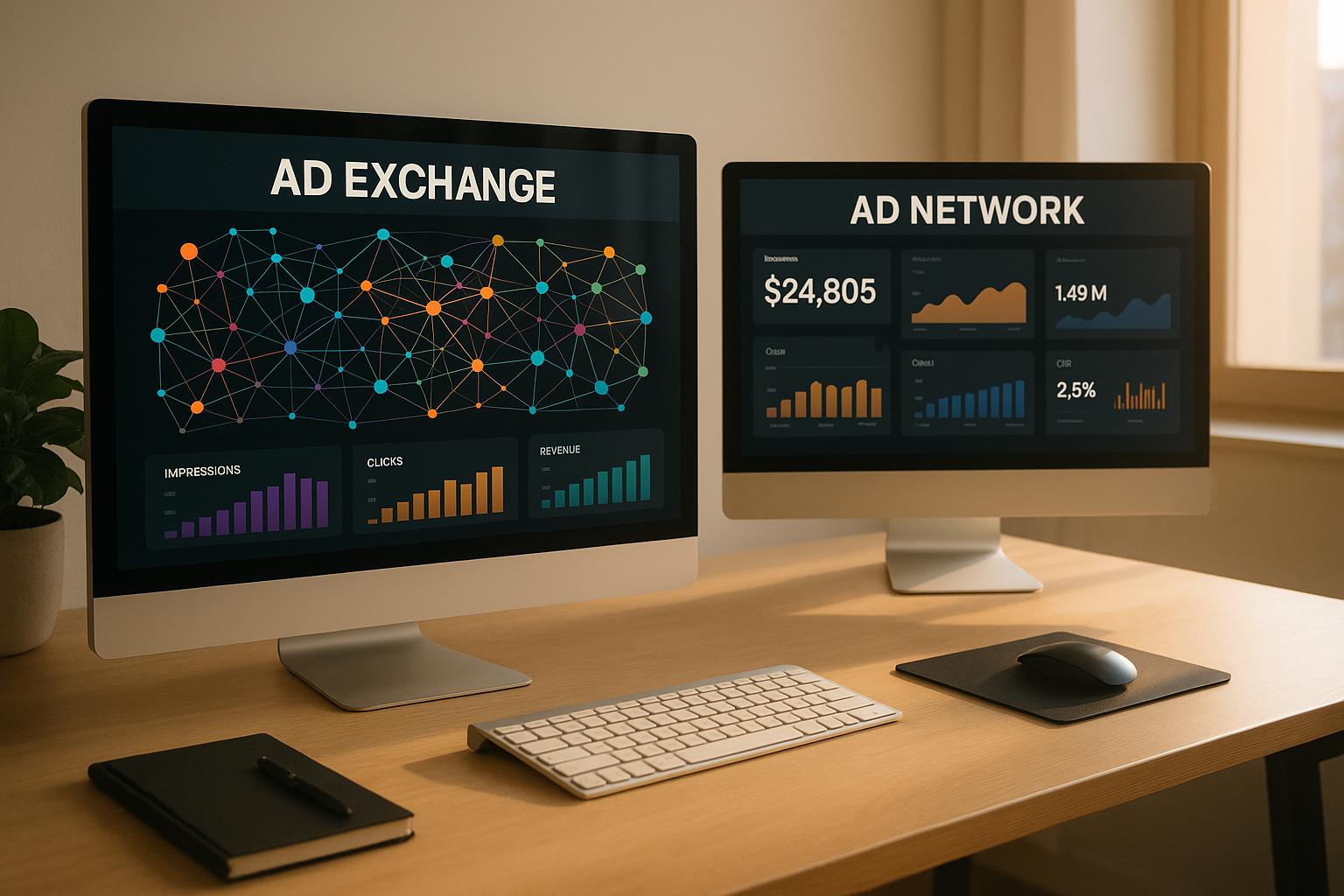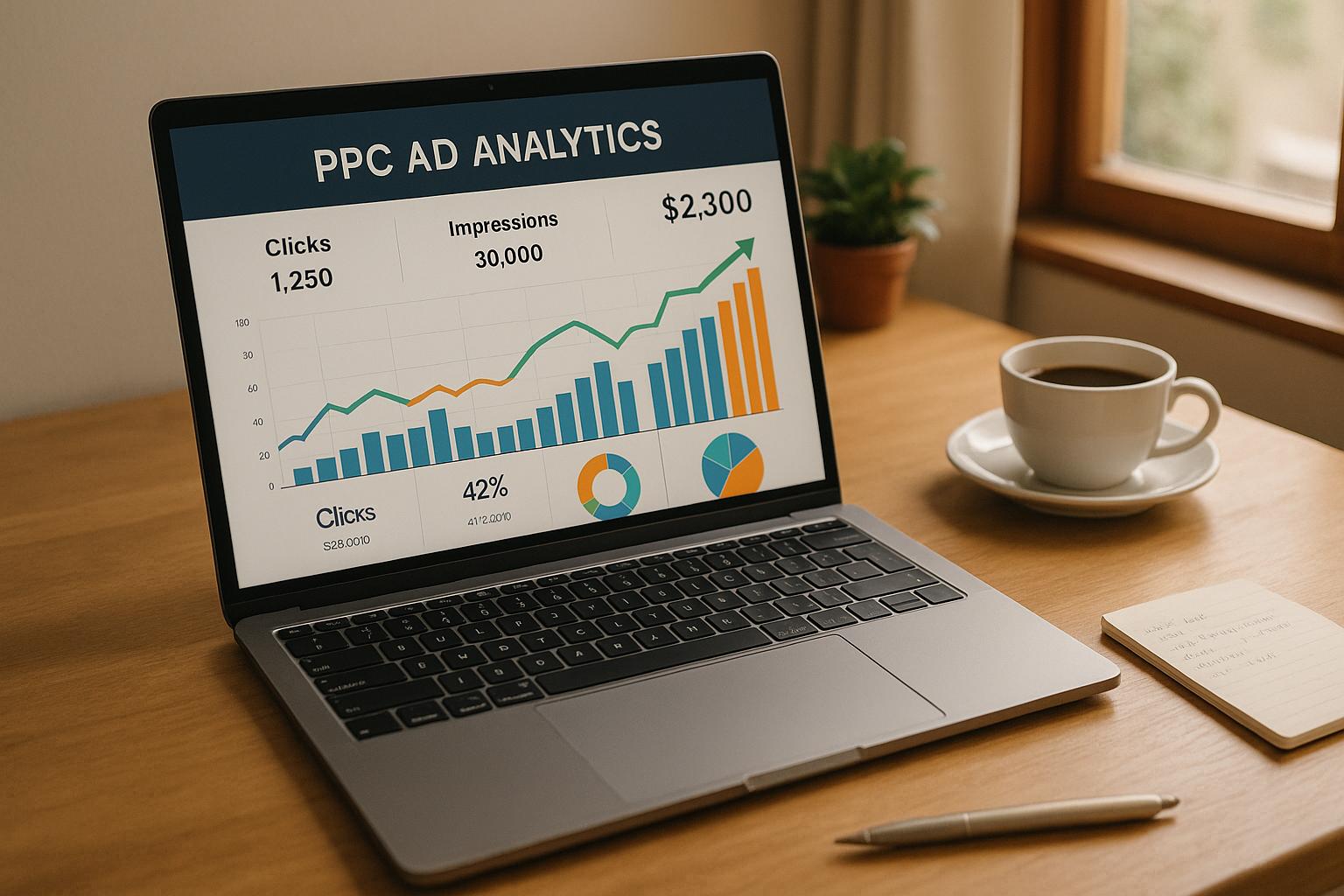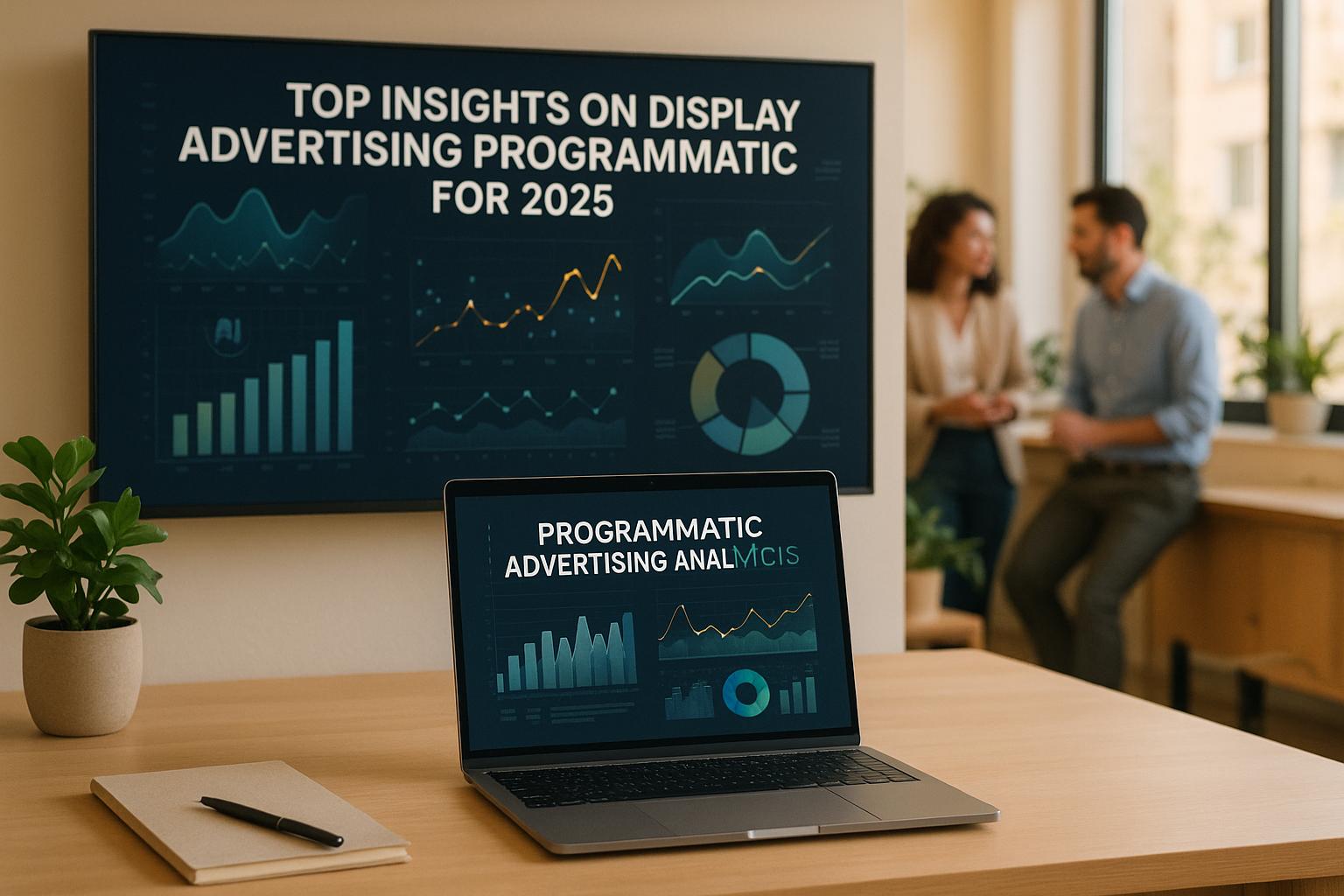Is Google AdSense still the best way to monetize your website? With strict policies, high rejection rates (95–96%), and a 32% revenue share, many publishers are looking for alternatives. Platforms like Ezoic, Mediavine, Media.net, and TinyAdz offer unique options depending on your traffic and goals. Here's a quick breakdown:
- TinyAdz: No traffic requirements. Great for small or new sites.
- AdSense: Beginner-friendly but strict policies and $100 payout threshold.
- Ezoic: AI-optimized ads, low $20 payout threshold, but can overwhelm with ads.
- Mediavine: High RPMs (up to $30), but requires 50,000 monthly sessions.
- Media.net: Focuses on contextual ads, strong for tier-1 traffic.
Quick Comparison
| Platform | Traffic Requirements | Payout Threshold | Revenue Potential | Key Features |
|---|---|---|---|---|
| TinyAdz | None | Not specified | Moderate for small sites | Customizable, easy setup |
| AdSense | None | $100 | Low to moderate | Beginner-friendly, large network |
| Ezoic | None (Access Now program) | $20 | Moderate to high | AI optimization, detailed analytics |
| Mediavine | 50,000 monthly sessions | $25 | High (up to $30 RPM) | Premium ads, fast site tools |
| Media.net | No official threshold | $100 | Moderate | Contextual targeting, Yahoo-Bing ads |
For new publishers, start with TinyAdz or AdSense. As traffic grows, consider Ezoic or Mediavine for higher earnings. Tailor your choice to your audience, traffic, and goals.
6 Best AdSense Alternative For Bloggers In 2025
1. TinyAdz
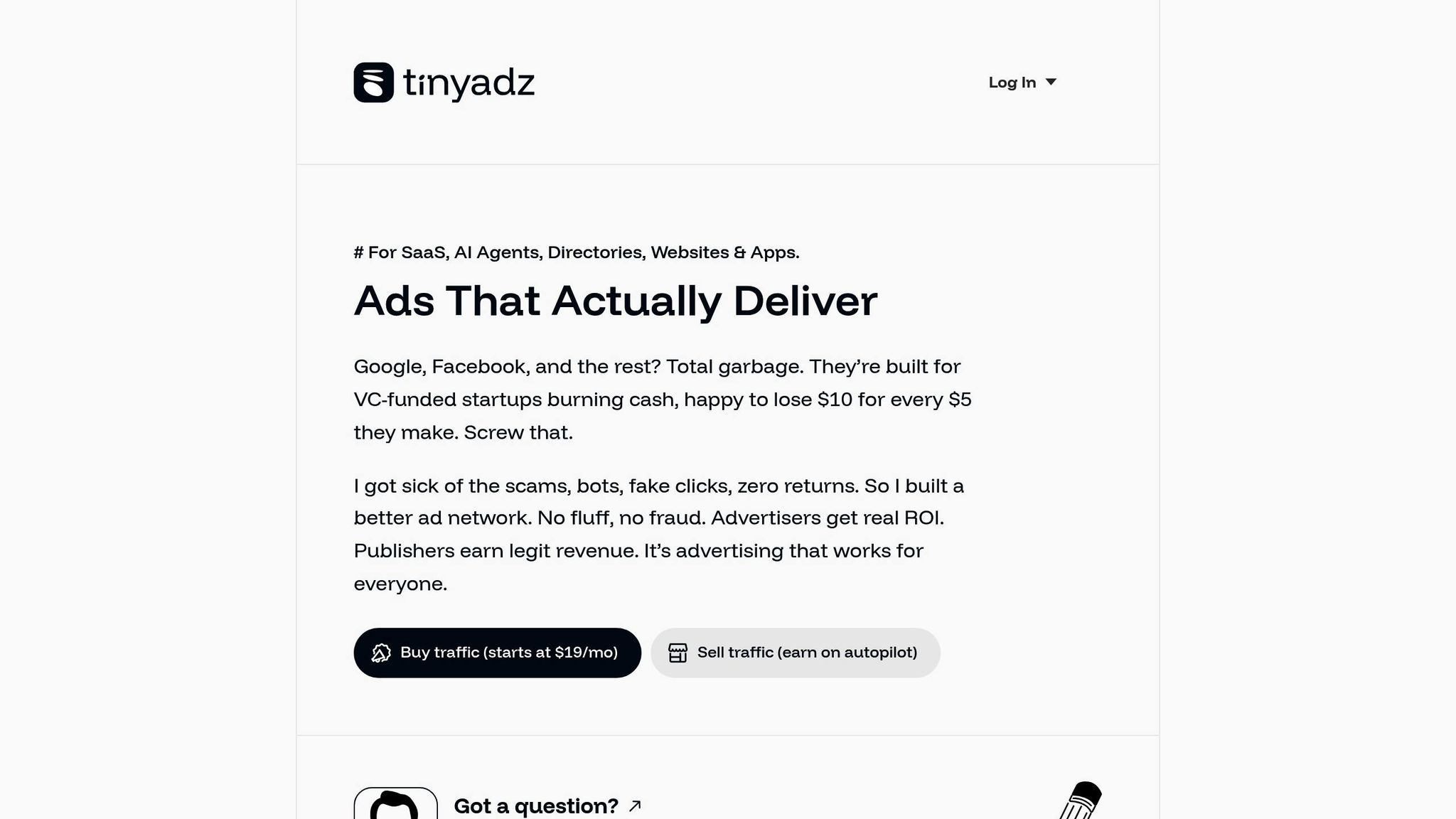
TinyAdz is a specialized advertising platform designed to connect small publishers with advertisers. By focusing on personalized ad placements that match a publisher's audience, it aims to boost click-through rates and overall ad performance.
Traffic Requirements
One of the standout benefits of TinyAdz is its accessibility. Unlike many ad networks, it doesn't have any minimum traffic requirements. This makes it an excellent option for newer websites or smaller blogs looking to monetize early in their journey. Many other platforms set high traffic thresholds, which can be a barrier for smaller publishers.
| Ad Platform | Traffic Requirements |
|---|---|
| TinyAdz | No minimum requirement listed |
| Mediavine | 50,000 monthly sessions |
| AdThrive | 100,000 monthly pageviews |
| Ezoic | No minimum traffic requirement |
| Monumetric | 10,000 monthly pageviews |
This open accessibility makes TinyAdz particularly appealing for niche creators, such as food bloggers or local business websites, who are just starting to build their audience.
Key Features
TinyAdz is designed with small and niche publishers in mind, offering tools that are easy to use and effective.
- Simple Setup: Its intuitive dashboard ensures even beginners can quickly manage their ads without a steep learning curve.
- Flexible Ad Formats: Publishers can customize ad placements to match their website's design, maintaining a smooth user experience.
In May 2024, TinyAdz reported hosting 1,062 websites, generating over a million views and securing 72 clicks.
Limitations
While TinyAdz shines in accessibility and customization for smaller, niche-focused websites, it may not be the best fit for high-traffic publishers. Larger websites often prefer networks with a more extensive history and a wider pool of advertisers. For those with significant traffic, TinyAdz is often better used as a secondary revenue source rather than a primary one.
Next, we'll dive into how TinyAdz compares to traditional AdSense, exploring the key differences between the two platforms.
2. AdSense
Google AdSense is one of the most well-known platforms for website monetization. It connects publishers with advertisers through an automated bidding system, taking a 32% commission and giving publishers the remaining 68%.
Traffic Requirements
AdSense doesn't enforce a minimum traffic requirement for joining. However, the approval process can be tough - 95–96% of new sites get rejected due to strict content and technical standards. The process can take weeks and often requires multiple rounds of adjustments to meet Google's guidelines. Even after approval, there are additional hurdles like payout thresholds.
Payout Thresholds
To receive payment, publishers must accumulate at least $100 in earnings. For smaller websites with limited traffic, reaching this amount can take months - or even years - posing a challenge for accessing revenue.
Key Features
AdSense operates on a Cost-Per-Thousand-Impressions (CPM) model, meaning publishers earn based on ad views and clicks. The platform offers competitive rates for a variety of website types, including blogs, forums, and online tools.
One major factor in earnings is geographic targeting. For example, clicks from U.S. visitors can earn up to 50 times more than clicks from regions like India or Pakistan. U.S. CPC rates generally range from $0.50 to $3.00. On average, AdSense CPM rates fall between $0.50 and $2.50 per thousand views. Websites with high-quality, family-friendly content and audiences from Tier-1 countries tend to earn more.
Limitations
Despite its popularity, AdSense has several drawbacks that make it less effective for certain publishers. Earnings are closely tied to traffic volume, so websites with low traffic often see minimal revenue. Additionally, some niches experience lower CPC rates, which can limit the earning potential for publishers in those categories.
AdSense also enforces strict policies regarding content and ad placement. These rules can sometimes result in ads that don’t align with a publisher’s brand, and violations can lead to penalties or even account suspension.
"AdSense is definitely one of the WORST ways to monetize a website (let alone niche websites)." - Anil Agarwal, Affiliate Marketer
Another challenge is Google's reduced transparency in recent years. The platform has limited the competitive data and metrics shared with advertisers and publishers, making it harder to analyze performance. Publishers flagged for traffic quality issues may also face ad serving limits, further reducing revenue potential.
For niche publishers, AdSense often falls short compared to other monetization options. Excessive or poorly placed ads can disrupt the user experience, leading to higher bounce rates and lower engagement. These limitations highlight why many publishers explore alternative platforms for better results.
3. Ezoic
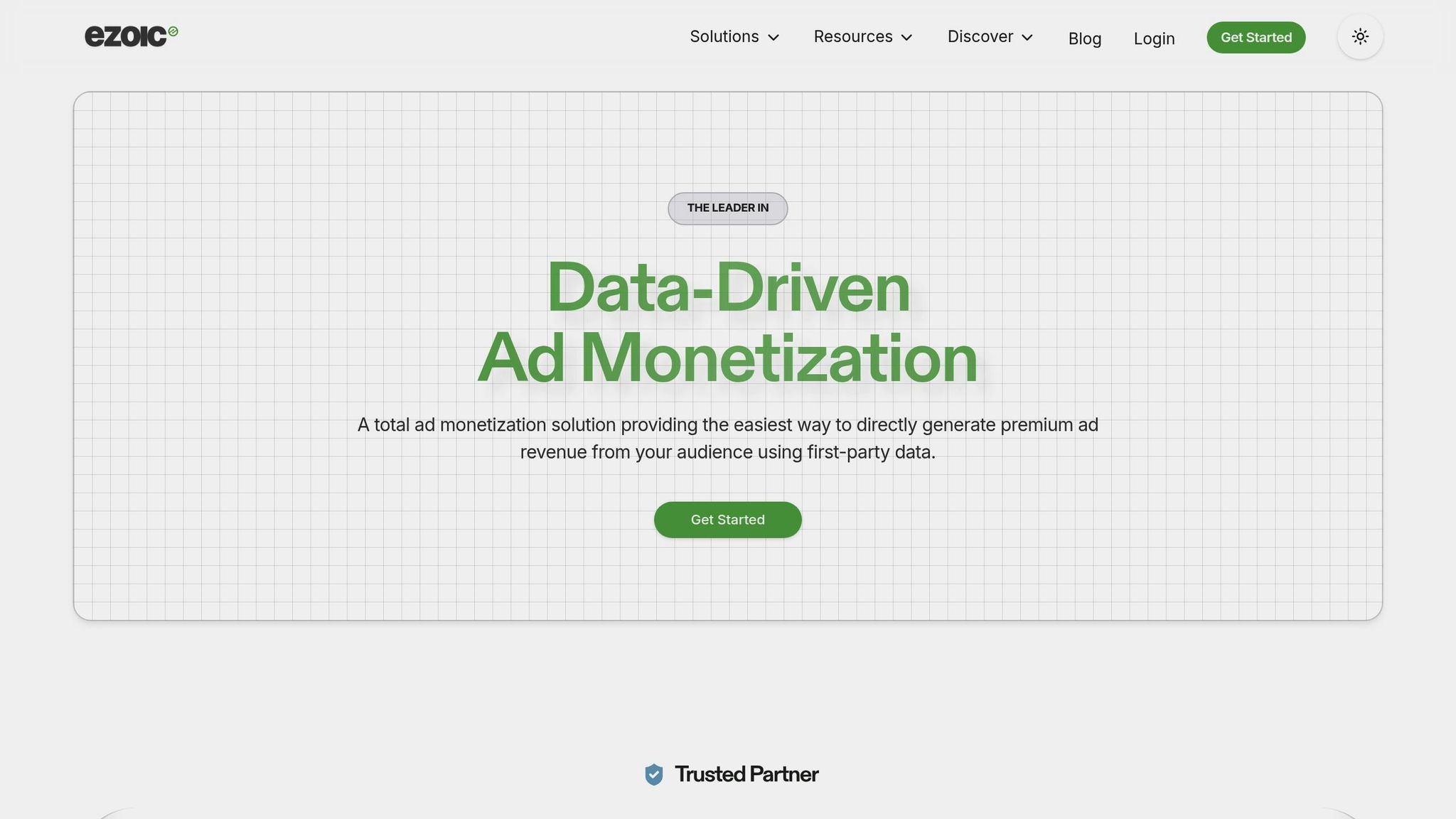
Balancing revenue generation with maintaining a smooth user experience is a challenge for any monetization platform, and Ezoic aims to address this with its AI-driven approach. The platform fine-tunes ad placements and site layouts to help publishers maximize earnings without compromising usability.
Traffic Requirements
Ezoic has dropped its previous requirement of 10,000 monthly pageviews, making it accessible to publishers of all traffic levels. However, for websites with fewer than 10,000 visitors per month, completing Ezoic's "Access Now" course is mandatory. This course introduces users to the platform and explains essential concepts. By removing strict traffic limits, Ezoic focuses more on content quality and ad compliance while offering better support for setting up its AI-powered ad configurations. This shift also allows publishers of all sizes to benefit from flexible payout options.
Payout Thresholds
Ezoic provides multiple payout methods, including checks, bank transfers, PayPal, international wire transfers, and Payoneer, giving publishers plenty of flexibility.
Key Features
Ezoic comes packed with useful tools like site speed analytics, AMP conversion, and layout testing. Its AI continuously adjusts ad placements to boost revenue while keeping user experience in mind. Serving over 200 million users monthly, Ezoic is also a Google Certified Publishing Partner. Publishers using its ad tester often see an average revenue increase of at least 50%. Additionally, the platform's analytics reveal that identified visitors can generate 41% higher earnings, while non-identified visitors see a 13% boost compared to traditional setups.
The Site Speed Accelerator tool claims to improve website speed by 200% on average. Ezoic also provides detailed revenue insights, breaking down data by device type and landing pages. The platform offers a free plan with a 10% revenue share and a premium plan priced at $49.99 annually or $5.99 monthly. While these features are attractive, the platform does come with some challenges.
Limitations
Ezoic's advantages are tempered by a few drawbacks. For instance, the platform requires a nameserver change, which gives it significant control over site operations and can sometimes slow down site performance. Overloading a site with ads through Ezoic can negatively impact user experience. Some publishers have reported drops in Google rankings, and the AI-driven optimizations don’t always deliver the expected results, potentially affecting traffic.
Beginners may find Ezoic's setup process daunting, especially if they lack technical expertise. Additionally, the premium plan requires upfront payment, which might not be ideal for publishers with tight budgets. Long-term contracts can also be restrictive, especially for sites that experience growth and might later qualify for better opportunities. Furthermore, the platform’s heavy ad placements have occasionally been linked to traffic and ranking declines, and its streamlined ad management system can feel overwhelming for those who prefer simpler solutions.
Despite these challenges, Ezoic remains a viable option for smaller websites that might not meet the eligibility criteria for other premium ad networks. It offers a way for publishers to monetize effectively, even if some trade-offs are involved.
sbb-itb-957fd63
4. Mediavine
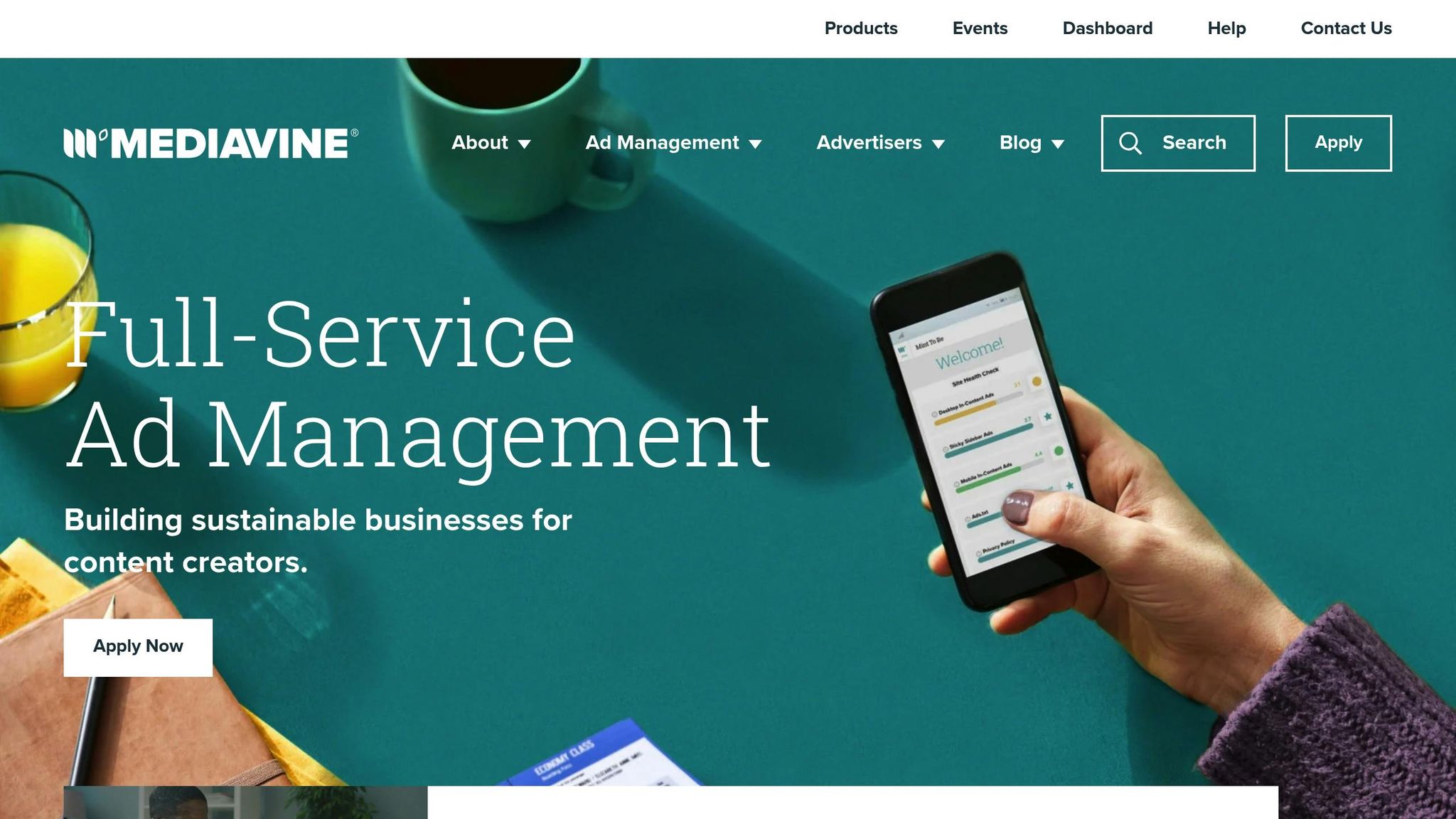
Mediavine stands out as a premium ad management platform, designed specifically for established publishers looking to monetize their content effectively. Unlike some platforms with lower entry barriers, Mediavine enforces strict criteria, ensuring it partners with creators who consistently engage their audiences.
Traffic Requirements
To join Mediavine, publishers need at least 50,000 monthly sessions (roughly 60,000 pageviews). However, hitting this traffic mark is just the beginning. Mediavine evaluates additional factors such as niche relevance, audience engagement, and the quality of organic traffic. Notably, the platform rejects about 72% of applicants, emphasizing its focus on maintaining high standards. Publishers must also ensure their content aligns with brand safety guidelines and that their traffic is organic. A good standing with Google AdSense and Google AdExchange is another essential requirement.
Payout Thresholds
Mediavine operates on a NET 65 payment schedule, meaning earnings are paid out 65 days after the end of the month in which they were generated. The minimum payout threshold is $25, making it accessible even for smaller payouts. Mediavine follows a 75/25 revenue-sharing model, allowing publishers to retain 75% of their ad earnings.
What’s more, long-term partnerships are rewarded with a 1% loyalty bonus each year, capped at 5% after five years. This means publishers can eventually earn up to 80% of ad revenue. For those with over 15 million ad impressions, the revenue share can climb even higher - up to 90%.
Key Features
As a Google Certified Publishing Partner, Mediavine offers a suite of advanced ad management tools. Beyond standard display ads, it supports video and native ads, all optimized for mobile devices. The platform utilizes technologies like header bidding and machine learning to maximize revenue potential.
Mediavine also provides publishers with additional tools through its Grow suite, which includes features like email sign-up forms, related posts widgets, and social sharing buttons. For those prioritizing site speed, the platform offers its custom-built Trellis theme, specifically designed for fast-loading websites. Publishers further benefit from detailed analytics, dedicated account managers, and technical support to ensure seamless ad operations.
Jon Dykstra, a successful niche site creator, shared his thoughts on Mediavine:
"Overall, Mediavine rocks. If you get accepted, go for it. I'm confident you won't be disappointed."
Mediavine prioritizes user-friendly, non-intrusive ad placements while leveraging advanced targeting to connect relevant ads with the right audiences.
Limitations
One of Mediavine's main challenges is its high traffic threshold, which can make it difficult for smaller publishers to qualify. This creates a bit of a paradox - publishers need significant traffic to join but might struggle to grow without the revenue Mediavine could provide.
Additionally, the NET 65 payment schedule can be a hurdle for those relying on quicker payouts to reinvest in their content or marketing efforts. Finally, even meeting all technical requirements doesn’t guarantee acceptance, as Mediavine places a strong emphasis on brand safety and content quality, potentially limiting opportunities for some publishers.
Next, we’ll take a closer look at Media.net to complete our comparison of premium ad management platforms.
5. Media.net
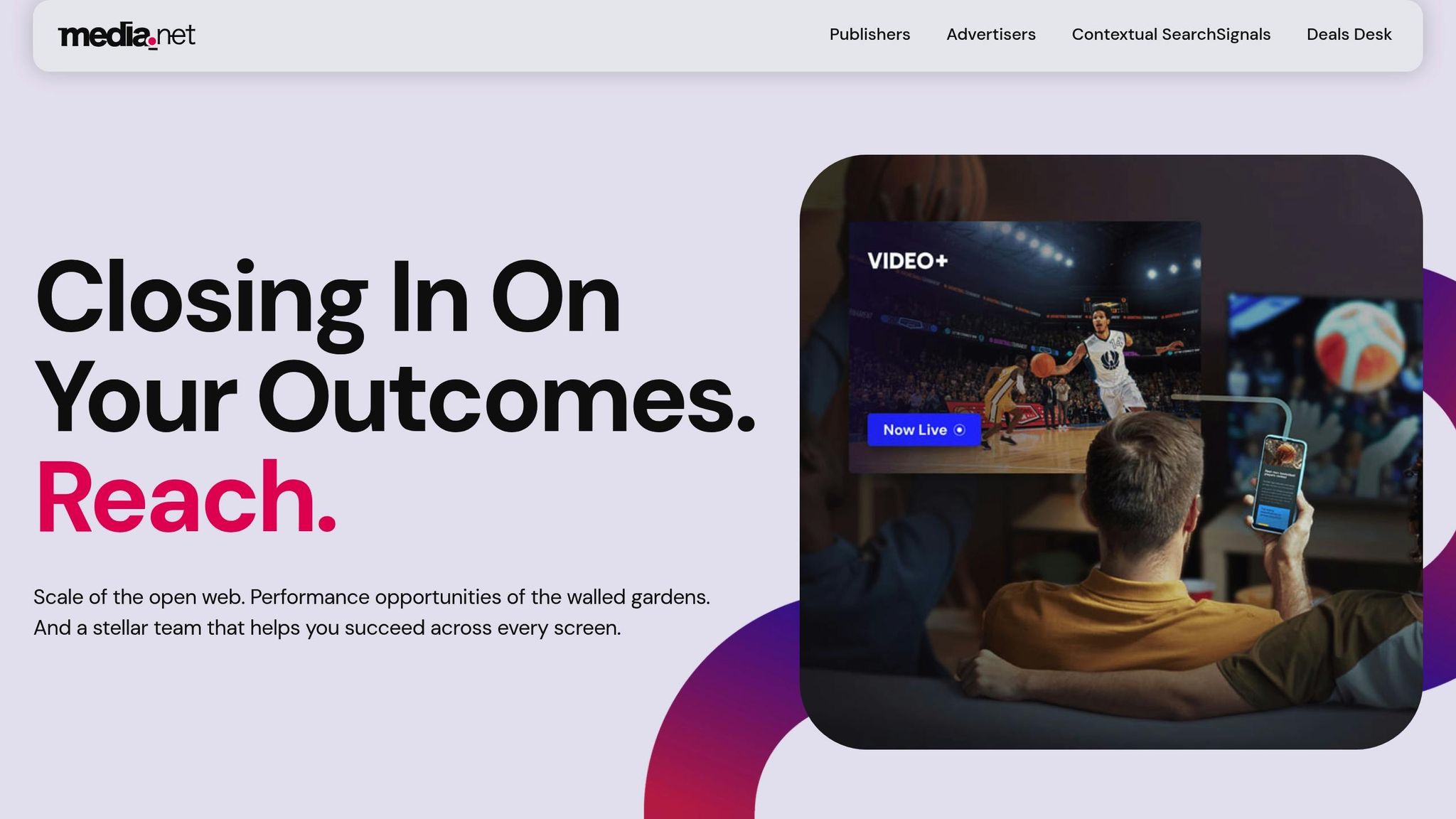
Media.net ranks among the largest contextual ad networks, delivering millions of ad impressions across a massive network of 500,000 websites. Instead of relying solely on traditional display advertising, Media.net focuses on contextual targeting, analyzing the content of a webpage to match it with relevant keywords that advertisers are bidding on. This makes it an appealing choice for publishers producing niche, high-quality content.
Traffic Requirements
Media.net doesn’t publicly share specific traffic requirements. Instead, it prioritizes content quality and prefers publishers with consistent traffic from tier-1 countries like the United States, Canada, and the United Kingdom. Publishers are encouraged to have traffic that’s primarily organic and to maintain well-crafted, premium content. While there’s no officially stated minimum traffic threshold, Media.net generally avoids working with websites that have very low monthly traffic.
Payout Thresholds
To cash out earnings, publishers must meet a minimum payout threshold of $100. Payments are processed every 30 days via wire transfer or Payoneer, exclusively in USD. Typical CPMs range from $1 to $1.25. For smaller publishers, reaching the $100 minimum can take time, especially if traffic volume is modest.
Key Features
Media.net connects publishers to advertisers using advanced contextual targeting technology. It benefits from exclusive demand through the Yahoo!-Bing network and premium DSPs, making it a strong player in the ad tech space. Back in 2015, Media.net reported $232 million in profit and paid over $450 million to publishers, with 90% of those earnings coming from U.S.-based traffic.
Some standout features include:
- Customizable ad units tailored to your site’s design
- Real-time reporting for performance tracking
- Cookie-free campaigns to comply with privacy regulations
- Header bidding and server-side ad insertion for better ad performance
- Anti-fraud technologies to ensure ad quality
- Dedicated support to help publishers maximize their revenue
Limitations
Media.net’s focus on tier-1 traffic can be a drawback for publishers whose audiences are predominantly located in other regions. Additionally, the platform’s lack of transparency regarding eligibility requirements may leave potential users unsure of their chances before applying. Another challenge is the USD-only payment system, which could lead to currency conversion headaches for international publishers. For smaller publishers, the $100 payout threshold combined with relatively low CPM rates might mean waiting longer to see their first payment.
Understanding the strengths and challenges of Media.net can help publishers weigh its suitability as part of their monetization strategy.
Platform Advantages and Disadvantages
As digital advertising continues to evolve, picking the right platform can have a big impact on both your revenue and user engagement. Each platform offers unique features that cater to different needs, so it’s essential to match those features with your goals as a publisher.
| Platform | Traffic Requirements | Payout Threshold | Key Advantages | Main Limitations |
|---|---|---|---|---|
| TinyAdz | None | Not specified | Targeted ad matching, traffic verification, supports multiple monetization channels | Newer platform with a limited track record |
| AdSense | None | $100 | Easy to set up, reliable payments, large advertiser base, beginner-friendly | Lower RPMs, limited ad control, strict policies |
| Ezoic | 10,000 monthly visitors | $20 | AI-powered optimization, RPMs up to $15 per 1,000 visitors, robust testing tools | Can be overly aggressive with ads, may impact user experience |
| Mediavine | 50,000 monthly visitors | $25 | Higher RPMs (up to $30), focuses on page speed, strong customer support | High traffic threshold for eligibility |
| Media.net | 5,000 monthly visitors | $100 | Contextual targeting, Yahoo-Bing network access, customizable ad units | Payments only in USD |
Key Considerations
Traffic and Payout Thresholds
For newer publishers, traffic requirements can be a hurdle. Platforms like TinyAdz and AdSense are open to all traffic levels, making them ideal starting points. In contrast, Mediavine requires a minimum of 50,000 monthly visitors, which might be out of reach for smaller sites. When it comes to payout thresholds, Ezoic stands out with its low $20 minimum, allowing quicker access to earnings compared to the $100 thresholds of AdSense and Media.net.
Revenue Potential
Revenue varies widely across platforms. Mediavine offers some of the highest RPMs, with publishers reporting earnings of up to $30 per 1,000 visitors. Ezoic’s AI-driven optimization has also helped some sites achieve eCPMs that are 50–150% higher than what they earned previously.
"Ezoic is a very good ad platform for sites that don't qualify or aren't accepted into Mediavine or AdThrive." – Jon Dykstra
User Experience
Ad placement and user experience are critical. Ezoic’s AI system can sometimes lead to excessive ads, which may slow down page load times. On the other hand, Mediavine takes a balanced approach, optimizing ad placements to maintain fast page speeds. TinyAdz focuses on delivering relevant ads to niche audiences without overwhelming users.
Support and Tools
Support services also differ. Ezoic provides hands-on assistance during onboarding and offers dedicated support teams. In contrast, AdSense operates as a self-service platform, which can be challenging for beginners. TinyAdz offers personalized matchmaking between publishers and advertisers, making it a good choice for niche sites looking for tailored ad partnerships.
Final Thoughts on Strategy
Many publishers start with accessible platforms like TinyAdz or AdSense to begin earning while they build up the traffic needed for premium networks like Mediavine. Diversifying revenue streams by combining platforms can also help reduce risks and maximize earnings.
Conclusion
Choosing the best monetization strategy as a US-based publisher depends on your current traffic levels, technical know-how, and long-term goals. These factors provide a clear roadmap for deciding how to maximize revenue while keeping your audience engaged.
For new publishers, platforms like TinyAdz and AdSense are excellent starting points because they don’t require minimum traffic. AdSense is particularly appealing for beginners, offering an easy setup and dependable payments. However, once your site surpasses 10,000 monthly sessions, it’s time to explore alternatives that can unlock greater revenue opportunities.
For publishers with over 10,000 visitors per month, Ezoic offers improved earnings per thousand visitors (EPMV), typically ranging from $3 to $18. Meanwhile, high-traffic sites can benefit from premium networks like Mediavine, which offers revenue per thousand impressions (RPM) between $10 and $50.
Geography also plays a crucial role in ad performance. AdSense tends to perform better in Tier 3 regions, while other platforms focus on Tier 1 and Tier 2 markets. This gives US-based publishers a distinct advantage when targeting premium geographic audiences.
One essential principle to keep in mind is maintaining user trust while optimizing revenue streams. As IncrementX puts it:
"Sustainable monetization is earning revenue or making money without losing out on your audience's trust. It is about finding that perfect opportunity where your content, ads, and audience all work in perfect symphony." – IncrementX
To achieve this balance, monitor key metrics like click-through rates (CTR) and user engagement. A CTR of 2% or higher is often a good benchmark for AdSense performance. Experimenting with A/B testing across different ad networks can help you determine which setup delivers the best results without compromising the user experience.
It’s also worth noting that static banner ads are expected to decline to just 36.2% of programmatic ad spend by 2026. This highlights the importance of diversifying beyond traditional display ads to future-proof your revenue strategy.
For practical steps, start with beginner-friendly platforms like TinyAdz or AdSense while focusing on growing your traffic. As your audience expands, transition to more premium networks that align with your niche and revenue goals. Matching your content style, control preferences, and revenue expectations with the right platform is key.
Ultimately, the best monetization strategy is one that aligns with your audience size, niche focus, and growth objectives. By staying adaptable to traffic levels, audience preferences, and evolving ad trends, you can build a sustainable and profitable revenue model in today’s competitive digital advertising landscape.
FAQs
What should I consider when selecting an ad monetization platform for my website?
When selecting an ad monetization platform, it's important to focus on a few critical elements to ensure it aligns with your website's goals and audience.
Start by assessing the platform's reliability and transparency. Choose a provider known for its solid reputation and clear, easy-to-use reporting tools. This ensures you can monitor your earnings and ad performance without hassle.
Next, think about the customization options. Can you adjust ad placements and formats to match your site's design and cater to your audience's preferences? The ability to customize ads can significantly improve user experience and boost your revenue.
Lastly, evaluate the support and resources the platform offers. Platforms with dedicated account managers or responsive technical support can help you fine-tune your strategy and quickly resolve any issues. Keeping these factors in mind will help you find the right monetization partner for your specific needs.
How does the payout threshold impact small website owners when choosing a monetization strategy?
The payout threshold significantly impacts how quickly smaller website owners can access their earnings. A lower threshold allows for faster cash flow, which can help cover day-to-day expenses or invest in improving the website. Plus, getting payments more quickly can be motivating, inspiring publishers to fine-tune their monetization strategies.
In contrast, a higher payout threshold can delay payments, which might lead to frustration and hinder growth. For small publishers, selecting a platform with a reasonable payout threshold is key to ensuring steady progress and maintaining financial stability.
How do location and traffic quality affect your ad revenue potential?
Both geographic location and traffic quality play a big role in shaping your ad revenue potential. Advertisers tend to focus their efforts on specific regions or demographics where their ads are more likely to connect with the audience. For instance, traffic from countries with higher purchasing power or areas with strong advertiser competition often results in a higher earnings per thousand impressions (EPMV).
Equally important is the quality of your traffic. Engaged users - those who interact with your content - boost ad performance because they are more likely to click on ads or take meaningful actions. This type of traffic is highly valued by advertisers, as it often leads to tangible outcomes like sales or conversions.
By targeting engaged visitors and tailoring your approach to match the preferences of your audience's location, you can unlock greater ad revenue opportunities.
